Aquaprase: A fresh start
by carly_midgley | July 30, 2018 3:28 pm
By Lauriane Lognay
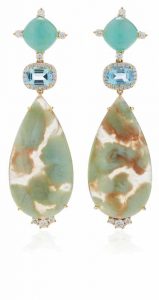 [1]
[1]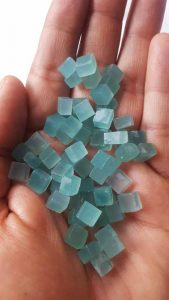 [2]
[2]
Aquaprase (also known as blue chalcedony) is a brand-new gemstone that opens up a world of possibilities for designers and jewellers alike. Its colour can be a deep lagoon turquoise in the blue-green spectrum. The stone itself is translucent to opaque and offers a vast range of different patterns to make designs interesting. It also has a good hardness of 7 to 7.5 on the Mohs scale and comes from the quartz family (as do stones like amethyst, citrine, and onyx).
At the moment, most jewellers are working with gemstones first discovered long before their births, such as rubies, sapphires, tourmalines, and turquoise. This new gem is the perfect opportunity to offer a fresh start and a unique idea to clients and designers alike.
A closer look
One of the most distinct features of blue chalcedony is its colour. As it comes from the quartz family, the two closest gemstones it can be compared to are chrysocolla (turquoise in colour with a forest to light green shade when associated with malachite) and chrysoprase (yellow-green). Compared to those two, the colour of aquaprase is more pleasing to the eye and is already a favourite of those who have worked with it.
From a gemmological point of view, aquaprase contains unusual amounts of moganite (not to be confused with the peach-coloured gem, morganite). It has the same chemical composition as quartz, but with a different type of crystallization in the growth of the gemstone. (Research was conducted to distinguish moganite from quartz in 1994, but the two gemstones had so few differences, the research team decided moganite should be a quartz. Ergo, aquaprase is in the quartz family.) The gemstone was discovered somewhere in Africa, with the exact location remaining a secret for the moment.
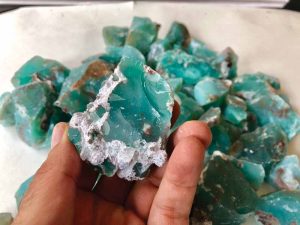 [3]
[3]As for the components causing the colour, aquaprase is composed of minerals including chromium, nickel, and iron. It contains far more minerals than its sisters—the colour in chrysocolla is caused by copper, and nickel gives chrysoprase its colour.
Inclusions
 [4]
[4]Photo courtesy Sam Woehrmann
This greenish-blue gemstone can be free of inclusions and clean, or it can come in a million different patterns when cut with inclusions. The inclusions often fall in the brownish to white colour range, offering an interesting contrast with the blue. Designers who work with it often prefer gems with inclusions over clean ones, because the included material is easy to work with and makes the gem look organic. However, collectors from all over love the clean material that offers a vibrant blue.
Everything that comes out of the mines is bought, whether it is of ‘low’ or ‘high’ quality. This is an ethical way to ensure miners get enough money for what they mine and there is enough material on the market. It also means the material is not only known for its highest quality. The organic look of the included gemstone presents a vast opportunity to the market and reflects the fact not only perfect specimens can have beauty and a story to tell.
Treatments
Aquaprase is as stable as it gets. No oil (as is used for emerald), dye (often seen in lapis lazuli), impregnation, or stabilization (as applied to turquoise or opal) is used on it. This stone neither requires nor responds to any treatment available today. It offers 100 per cent natural beauty.
The fight that started it all
Yianni Melas, a Greek influencer in the gemmology world and an advocate for human rights, is the one who discovered the gem and named it ‘aquaprase.’ The term ‘aqua’ represents the blue of the Greek Aegean Sea. ‘Prase,’ which means ‘leek’ in ancient Greek, reflects the colour green. Melas is also trying to get the stone approved as a January birthstone, since it was discovered in January.
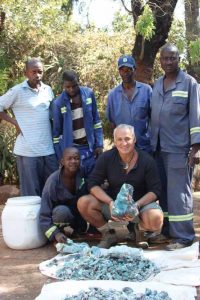 [5]
[5]Photos courtesy Yianni Melas
The gemstone first came out because of a fight with gemmological labs. The first laboratory that came across it was a major Swiss lab, which identified it as chrysoprase. Since the colour was nothing like chrysoprase (being more of a blue-green than a yellow-green), Yianni Melas was unconvinced. He fought for a new diagnosis and brought the stone to the Gemological Institute of America (GIA) for a final identification.
The institute later revealed it was a new type of chalcedony. (To read the article in which the Gemological Institute of America [GIA] identifies the gem, click here[6].) The colour is so unique, it could not be attributed to chrysocolla or chrysoprase. The chemical composition and certain tests also helped determine this was a different gemstone.
Discovery of the 21st century
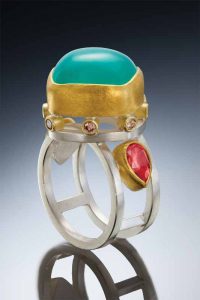 [7]
[7]
Photo courtesy Sam Woehrmann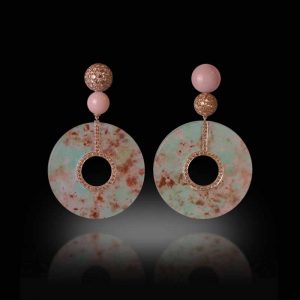 [8]
[8]
Photo courtesy Bert Ternat
Antoinette Matlins, who is a well-respected author and a gemstone/jewellery expert, called aquaprase “the discovery of the 21st century” in one of her latest books. Since then, the phrase “discovery of the 21st century” has been used in a multitude of contexts when this gemstone is mentioned.
Rough aquaprase was sold for the first time at Mineralientage München in Germany this year. Those at the show seemed to love it, even though German designers are often fairly conservative in their styles of jewellery. I also had the chance to see and buy some at the Tucson gem show[9]. The gem has gotten overwhelmingly positive feedback and enthusiastic reactions so far. People love the pattern of this colourful stone.
Aquaprase is a gem that is inexpensive, hard, beautiful, and easy to use in designs. It is stable, and the colour never fades. The fact no applicable treatments exist yet makes it easier for us to identify and buy it.
It will be interesting to see where this new discovery will take us in the world of jewellery—and if, one day, aquaprase will stand proud with the other gemstones we know so well.
 [10]Lauriane Lognay is a fellow of the Gemmological Association of Great Britain (FGA), and she has won several awards. She is a gemstone dealer working with jewellers to help them decide on the best stones for their designs. Lognay is the owner of Rippana Inc., a Montréal-based company working internationally in coloured gemstone, lapidary, and jewellery services. She can be reached via e-mail by contacting rippanainfo@gmail.com.
[10]Lauriane Lognay is a fellow of the Gemmological Association of Great Britain (FGA), and she has won several awards. She is a gemstone dealer working with jewellers to help them decide on the best stones for their designs. Lognay is the owner of Rippana Inc., a Montréal-based company working internationally in coloured gemstone, lapidary, and jewellery services. She can be reached via e-mail by contacting rippanainfo@gmail.com.
- [Image]: https://www.jewellerybusiness.com/wp-content/uploads/2018/07/Designed-by-Pamela-Huizenga-based-in-florida.jpg
- [Image]: https://www.jewellerybusiness.com/wp-content/uploads/2018/07/Photo-by-Yianni-Melas-Preformed-Aquaprase-rough.jpg
- [Image]: https://www.jewellerybusiness.com/wp-content/uploads/2018/07/IMG_4908.jpg
- [Image]: https://www.jewellerybusiness.com/wp-content/uploads/2018/07/Design-by-Sam-Woehrmann-Based-in-San-Fransisco-.jpg
- [Image]: https://www.jewellerybusiness.com/wp-content/uploads/2018/07/Yianni-Melas-on-the-picture-with-the-mining-team-sorting-through-the-rough-from-the-mine.jpg
- here: https://www.gia.edu/gems-gemology/winter-2015-gemnews-new-natural-color-bluish-green-chalcedony
- [Image]: https://www.jewellerybusiness.com/wp-content/uploads/2018/07/Design-by-Sam-Woehrmann-Based-in-San-Fransisco-3-.jpg
- [Image]: https://www.jewellerybusiness.com/wp-content/uploads/2018/07/designed-by-Bert-Ternat-based-in-Hong-kong-with-conch-pearls-1.jpg
- Tucson gem show: https://www.jewellerybusiness.com/features/tucson-2018-the-gem-show-rollercoaster/
- [Image]: https://www.jewellerybusiness.com/wp-content/uploads/2018/07/headshot.jpg
Source URL: https://www.jewellerybusiness.com/features/aquaprase-a-fresh-start/